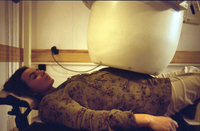
“The frequently reported special awareness of a mother for the well-being of her unborn child may be in part attributable to synchronization of their heartbeats,” says Jürgen Kurths, co-author of the study, from the Potsdam Institute for Climate Impact Research (PIK). The research team headed by Kurths and Peter van Leeuwen from Dietrich Grönemeyer’s Chair of Radiology and Microtherapy at the University of Witten/Herdecke has developed an algorithm to identify the synchronization epochs in the data.
The mathematical approach opens up the possibility to examine this scarcely investigated interaction between partly independent but partly closely linked physiological systems. “These exciting results demonstrate the importance of interdisciplinary teams in medicine,” says Grönemeyer, whose department has specialised for years in interdisciplinary work between physicians, engineers, mathematicians and scientists.

For the new study, six women between 34 and 40 weeks of pregnancy were examined using a magnetocardiograph. This device records the magnetic fields generated by the activation of the heart muscle. The heartbeat is coordinated by specialised heart muscle cells that initiate action potentials. These weak electrical impulses travel through other specialised cells to the working muscle cells of the heart. This results in weak magnetic fields which can be recorded by magnetocardiography with no contact or stress for the mother or child.
The pregnant women were asked to maintain a pre-given respiratory rhythm for five minutes, breathing 10, 12, 15 or 20 times per minute. Higher breathing rates lead to a greater number of synchronisation epochs in mother and child heartbeat when compared to normal or slower rates, the researchers report. “We were able to show that the cardiac systems of the mother and her unborn child interact,” says Kurths. The synchronisation does not result from identical foetal and maternal heart rates (one to one), but in fixed heart rate ratios of the child to that of the mother of, for example, four to three or three to two (see figure).
The researchers detected this hidden interaction by applying an innovative technique of analysis, called “twin surrogates”. In this method, first independent copies of the underlying system are generated. Then, the surrogate data are used to identify the synchronisation epochs statistically.
“This method improves our insight into the prenatal development of the cardiac system and possibly the nervous system,” says Peter van Leeuwen. Examinations of heartbeat synchronisation may help to detect pathological conditions of the foetus.
“The method can also be applied to investigate so called teleconnections in the climate system,” says Kurths. Teleconnections are mostly weak but far-reaching interactions in time and place. They exist for example between the El Niño phenomenon in the Eastern Pacific and the monsoon in India. The search for synchronisation of these phenomena can provide information about how they are interlinked.
“Synchronisation may occur anywhere where two complex systems are coupled,” says Kurths. It could be described as a “feeling” of one dynamical system for the existence of another. Synchronisation defines the way the two systems react to each other and to external influences. “Another potential application is research on the loss of biodiversity caused by human land use,” says Kurths. The method could provide clues as to why or at what point the fragmentation of an ecosystem by roads or plantations negatively affects its species richness.
For further information please contact the PIK press office:
Phone: +49 331 288 25 07
E-mail: press@pik-potsdam.de





